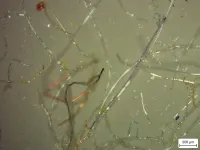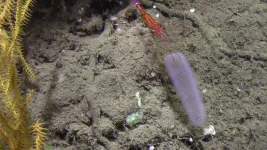(Press-News.org) When COVID-19 patients began filling up ICUs throughout the country in 2020, health care providers faced difficult decisions. Health care workers had to decide which patients were most likely to recover with care and which were not so resources could be prioritized.
But a new paper from the University of Georgia suggests that unconscious biases in the health care system may have influenced how individuals with intellectual disabilities were categorized in emergency triage protocols.
The state-level protocols, while crucial for prioritizing care during disasters, frequently allocated resources to able-bodied patients over ones with disabilities, the researchers found.
The study, published in Disaster Medicine and Public Health Preparedness, found that some states had emergency protocols saying that individuals with brain injuries, cognitive disorders or other intellectual disabilities may be poor candidates for ventilator support. Others had vague guidelines that instructed providers to focus resources on patients who are most likely to survive. Adults with disabilities are significantly more likely to have comorbidities, such as heart disease and diabetes. In the case of COVID-19, those conditions were considered risk factors for poor outcomes, relegating these patients to the bottom of care hierarchy.
To compound the problem, COVID-19 hospital protocols that banned visitors often shut out advocates and family members who might have been able to advocate for these individuals. For patients unable to communicate their needs, the situation could easily turn deadly.
"I think when you leave people out of the conversations making these decisions, you see an issue like structural discrimination and bias," said Brooke Felt, lead author of the paper who graduated from UGA in 2020 with Master of Social Work and Master of Public Health degrees.
"Ableism, which is when people discriminate against those with disabilities and favor people with able bodies, is just so ingrained into the health care system. It is definitely a bias that a lot of people have, and sometimes people don't even recognize it."
Priority of care
Triaging, or prioritizing care and resources during emergencies or disasters, can be a subjective process. State protocols offer a degree of guidance about how to allocate resources, but in the moment, decisions about care often come down to individual health care providers.
In the case of the COVID-19 pandemic, hospitals were overwhelmed with patients and frequently had to make these judgment calls without extensive medical histories or patient advocates.
Curt Harris, corresponding author of the paper and director of the Institute for Disaster Management in UGA's College of Public Health, stressed that this research isn't an attack on clinical providers, who have shouldered an enormous burden throughout the pandemic.
"I do not believe clinicians are deliberately doing this," he said. "I just don't think they have been given the requisite education needed for population-level health issues, nor is it easy for clinicians to reconcile what constitutes high quality of life for patients with intellectual disabilities. This is more of an educational opportunity for clinicians to recognize that an issue exists and begin to make systemic changes, so we do not repeat the same mistakes in the future."
Addressing inequities
At the center of these emergency protocols is the underlying implication that an able-bodied person is more worthy of life-saving treatments than one who is intellectually disabled, Felt said.
One way to address this oversight would be to integrate social workers into the emergency response process, the authors said. They can act as advocates for those who can't speak on their own behalf.
"Involving social workers means you may be more likely to have someone who recognizes the structural inequalities, biases and discrimination and can bring those issues more into focus so they can be addressed," said Felt.
Altering pre-medical and medical education curricula to incorporate training on how to work with individuals with disabilities--something that often isn't covered--could also go a long way in closing the gap in care.
Felt had asked a friend in a medical program about bias and discrimination trainings in his coursework. She was shocked to learn his clinical education did not cover this topic.
"I feel like that should be a foundational class," she said. "That's something that definitely needs to change."
INFORMATION:
(Boston)--If you come from a family where people routinely live well into old age, you will likely have better cognitive function (the ability to clearly think, learn and remember) than peers from families where people die younger. Researchers affiliated with the Long Life Family Study (LLFS) recently broadened that finding in a paper published in END ...
Brain implants are used to treat neurological dysfunction, and their use for enhancing cognitive abilities is a promising field of research. Implants can be used to monitor brain activity or stimulate parts of the brain using electrical pulses. In epilepsy, for example, brain implants can determine where in the brain seizures are happening.
Over time, implants trigger a foreign body response, creating inflammation and scar tissue around the implant that reduces their effectiveness.
The problem is that traditional implants are much more rigid than brain tissue, which has a softness comparable to pudding. Stress between the implant and ...
A new auroral phenomenon discovered by Finnish researchers a year ago is probably caused by areas of increased oxygen atom density occurring in an atmospheric wave channel. The speculative explanation offered by the researchers gained support from a new study.
Observations made by University of Helsinki researchers increased the validity of a speculative mechanism according to which a type of aurora borealis named 'dunes' is born. In the new study, photographs of the phenomenon taken by an international group of hobbyists in Finland, Norway and Scotland were compared to concurrent satellite data.
The rare type of aurora borealis was seen in the sky on 20 January 2016 and recorded in photos taken by ...
This overlay shows radio (orange) and infrared images of a giant molecular cloud called W49A, where new stars are being formed. A team of astronomers led by Chris DePree of Agnes Scott College used the National Science Foundation's Karl G. Jansky Very Large Array (VLA) to make new, high-resolution radio images of this cluster of still-forming, massive stars. W49A, 36,000 light-years from Earth, has been studied for many decades, and the new radio images revealed some tantalizing changes that have occurred since an earlier set of VLA observations in 1994 and 1995.
The ...
Scientists have developed a new "key-hole surgery" technique to extract metals from the earth - which could revolutionise the future of metal mining
A team of international researchers, including Dr Rich Crane from the Camborne School of Mines, University of Exeter, have developed a new method to extract metals, such as copper, from their parent ore body.
The research team have provided a proof of concept for the application of an electric field to control the movement of an acid within a low permeability copper-bearing ore deposit to selectively dissolve and recover the metal in situ.
This is in contrast to the conventional approach for the mining of such deposits ...
Swansea University scientists have uncovered potentially dangerous chemical pollutants that are released from disposable face masks when submerged in water.
The research reveals high levels of pollutants, including lead, antimony, and copper, within the silicon-based and plastic fibres of common disposable face masks.
The work is supported by the Institute for Innovative Materials, Processing and Numerical Technologies (IMPACT) and the SPECIFIC Innovation & Knowledge Centre
Project lead Dr Sarper Sarp of Swansea University College of Engineering said:
"All of us need to keep wearing masks as they are essential in ending the pandemic. But we also urgently need more research and regulation on mask production, so we can reduce any risks to the environment and ...
Pyrosomes, named after the Greek words for 'fire bodies' due their bright bioluminescence, are pelagic tunicates that spend their entire lives swimming in the open ocean. They are made up of many smaller animals, known as zooids, that sit together in a tubular matrix, known as tunic (hence the name pelagic tunicates). Because they live in the open ocean, they generally go unnoticed. In spite of this, increasing research points to their importance in marine environments, as they can form dense blooms that impact food web dynamics and contribute to the movement and transformation of organic carbon.
The study conducted with GEOMAR research vessel POSEIDON in 2018 and 2019 in the vicinity of the Cabo Verde Islands, of which the results have now been published ...
Scientists at the Walter Reed Army Institute for Research demonstrated that biomarkers associated with traumatic brain injury were elevated among law enforcement and military personnel, particularly in active duty participants with longer duration of service. Most notably, these elevated biomarker levels were observed in individuals without a diagnosed brain injury or concussion.
Some law enforcement and military personnel are regularly exposed to low levels of blast, particularly during training, due to the use of explosive charges and high caliber weapons. Understanding effects from these occupational exposures is a military health care priority to improve ...
FAYETTEVILLE, Ark. - A new map including rover paths of the Schrodinger basin, a geologically important area of the moon, could guide future exploration missions.The map was created by a team of interns at the Lunar and Planetary Institute, including Ellen Czaplinski, a University of Arkansas graduate student researcher at the Arkansas Center for Planetary Sciences and first author of a paper published in The Planetary Science Journal.
The researchers identified significant geologic features of the Schrödinger basin, located near the lunar south ...
Researchers at the U.S. Department of Energy's National Renewable Energy Laboratory (NREL) developed a breakthrough in energy-efficient phototransistors. Such devices could eventually help computers process visual information more like the human brain and be used as sensors in things like self-driving vehicles.
The structures rely on a new type of semiconductor--metal-halide perovskites--which have proven to be highly efficient at converting sunlight into electrical energy and shown tremendous promise in a range of other technologies.
"In general, these perovskite semiconductors are a really unique ...




